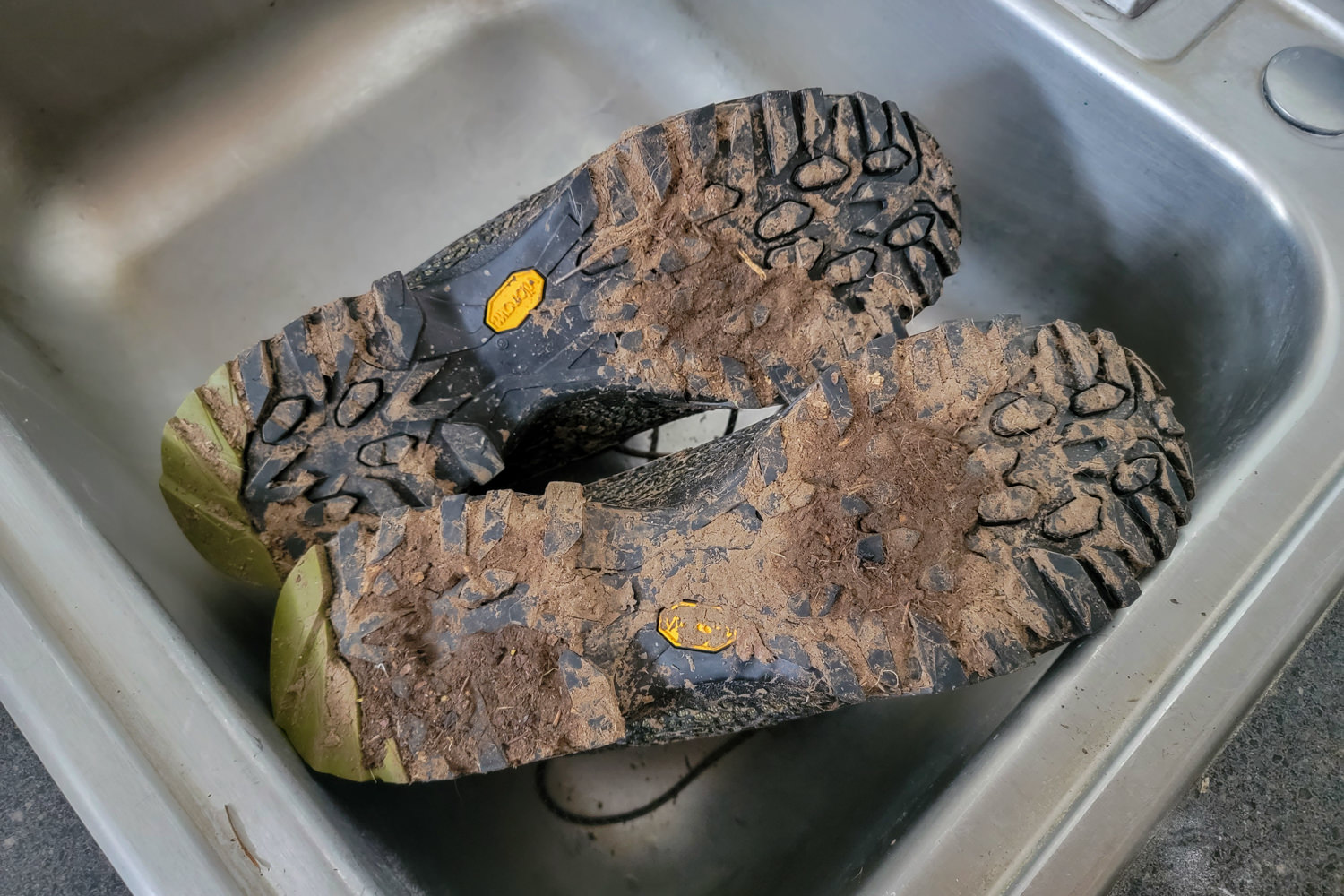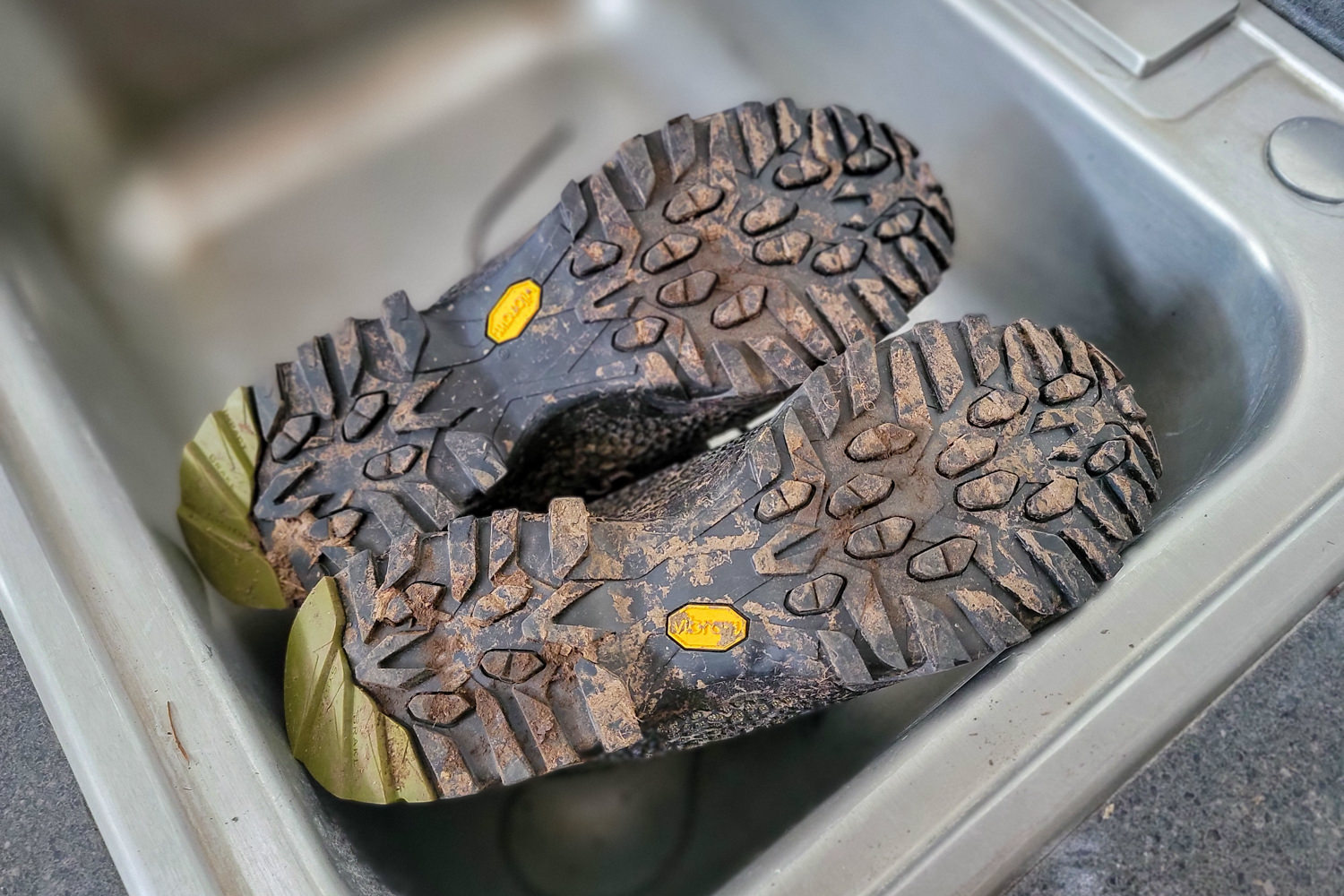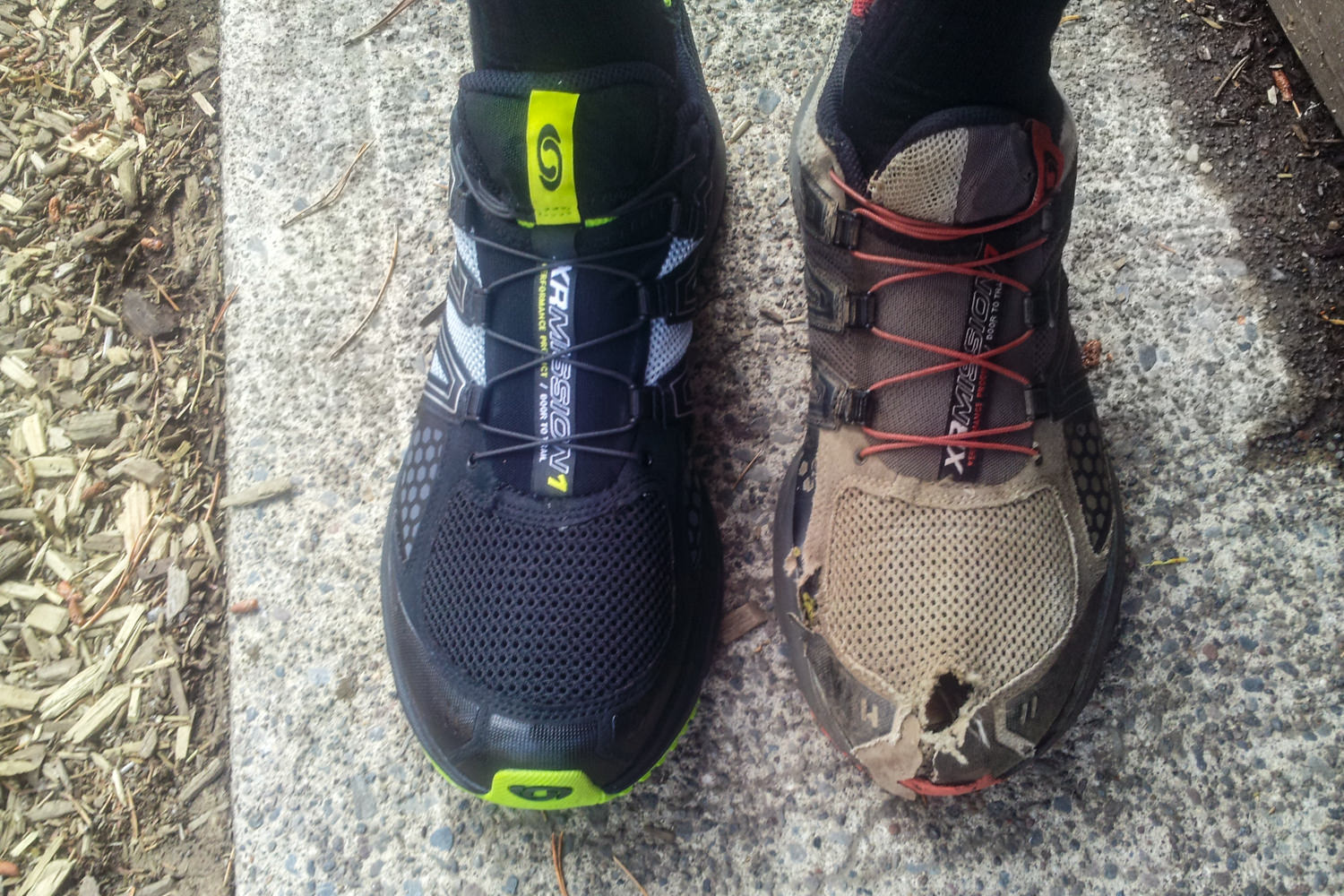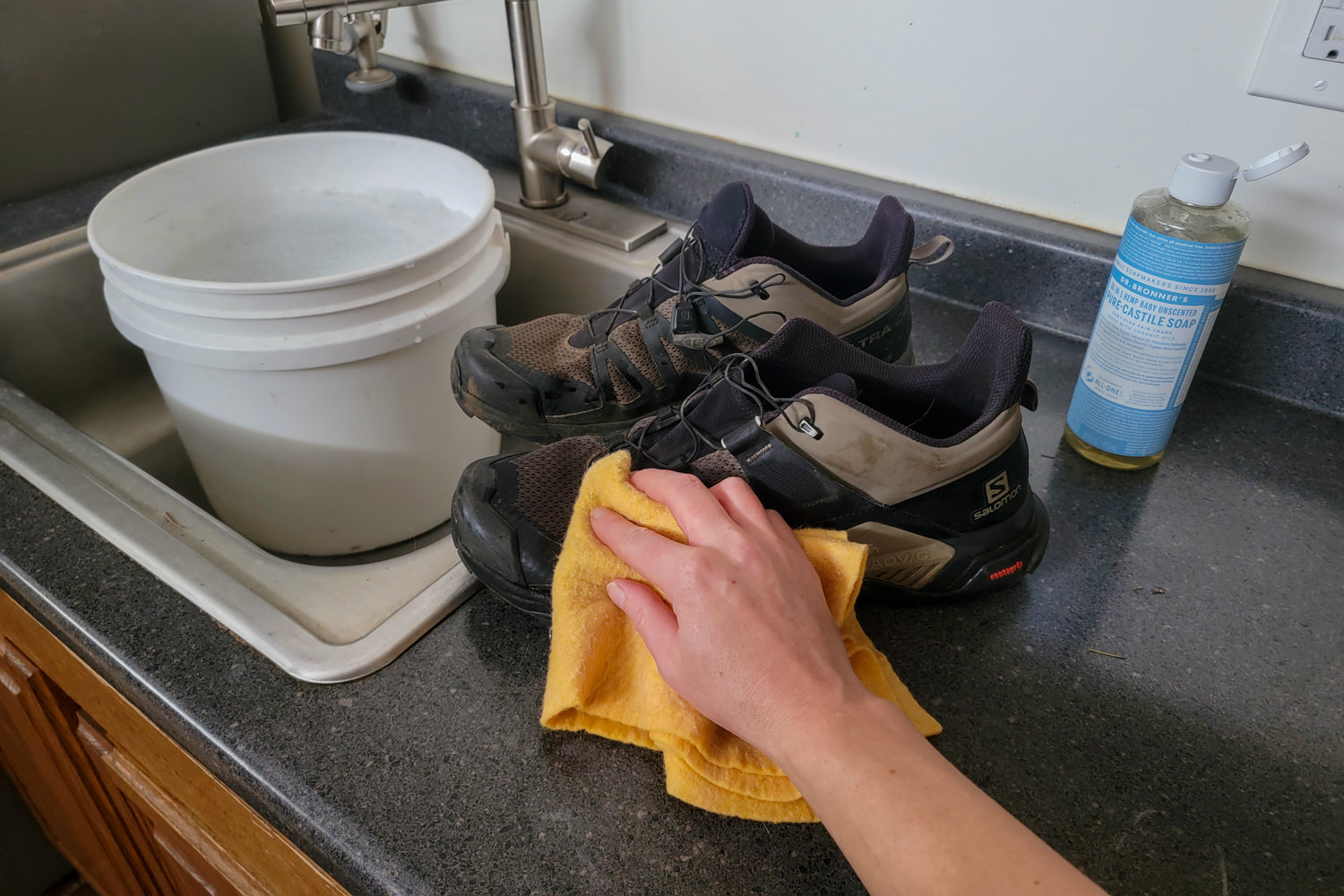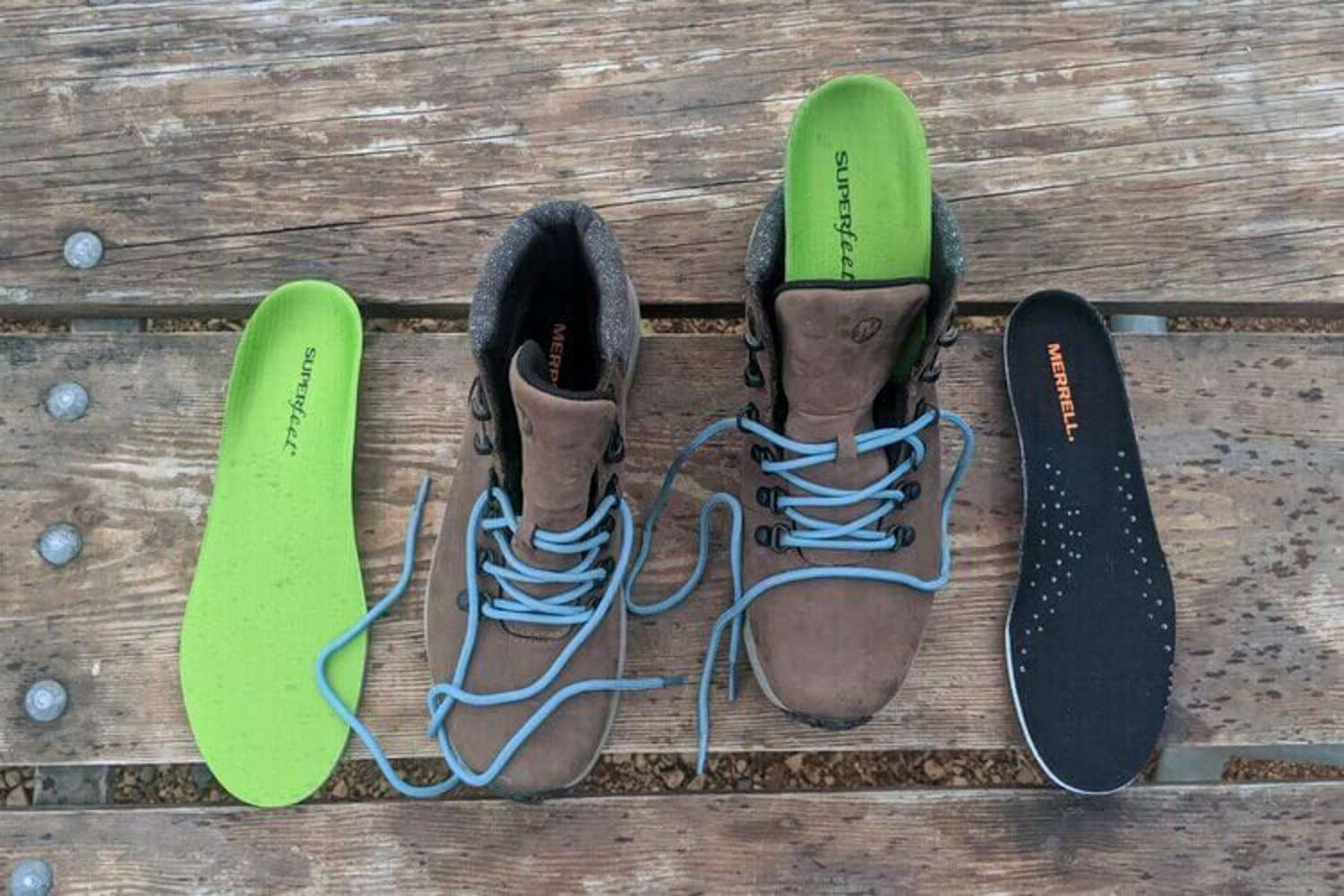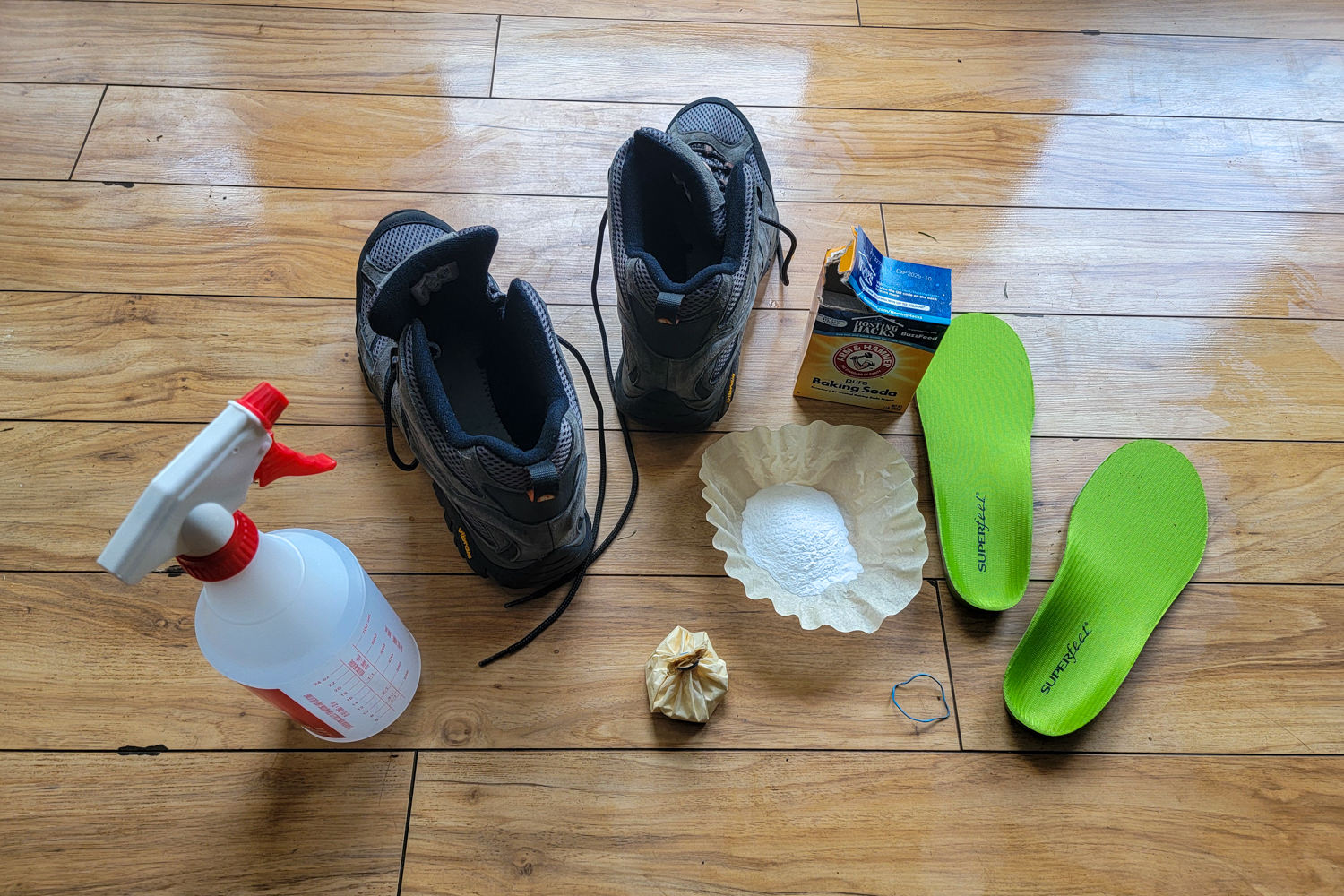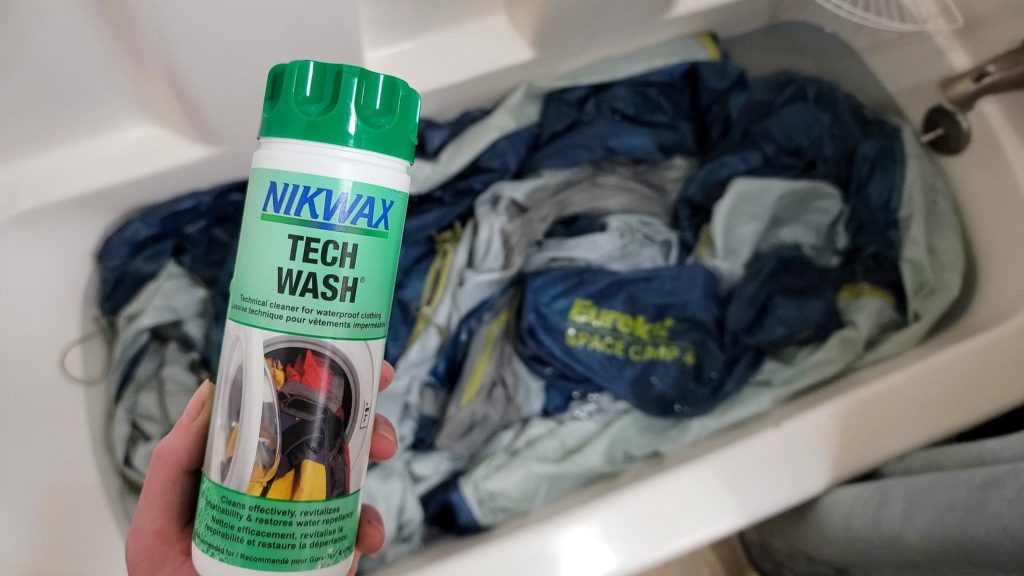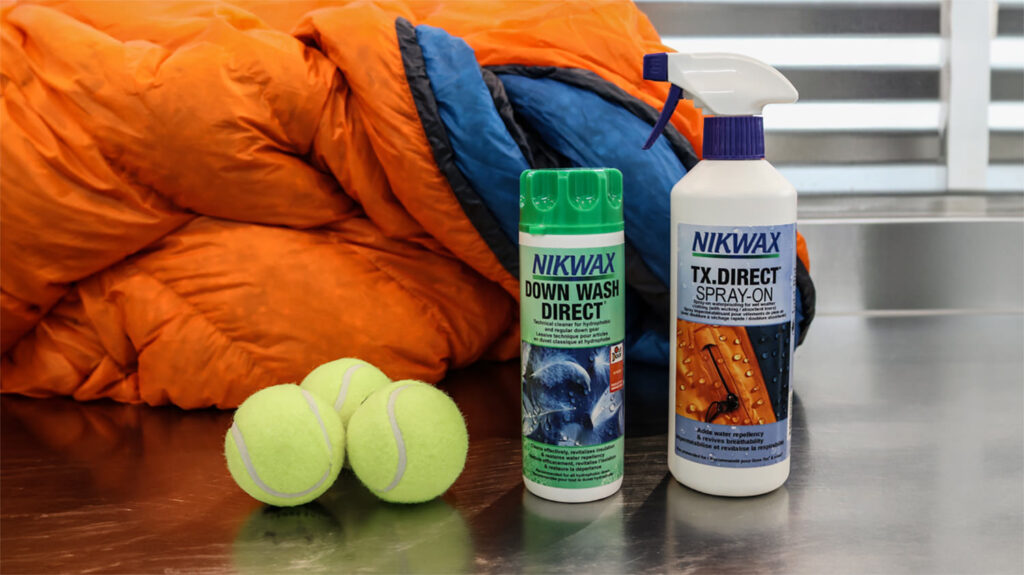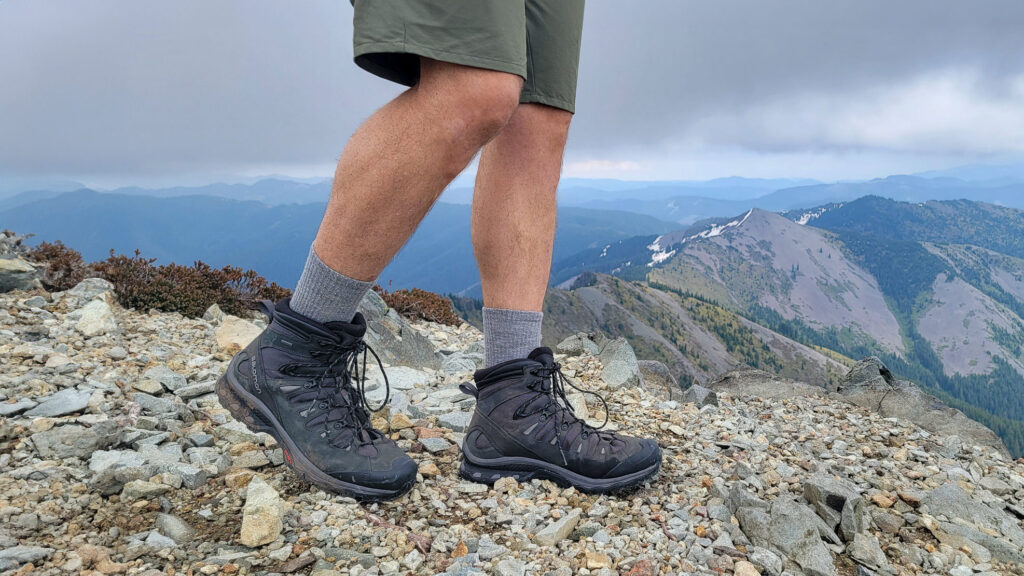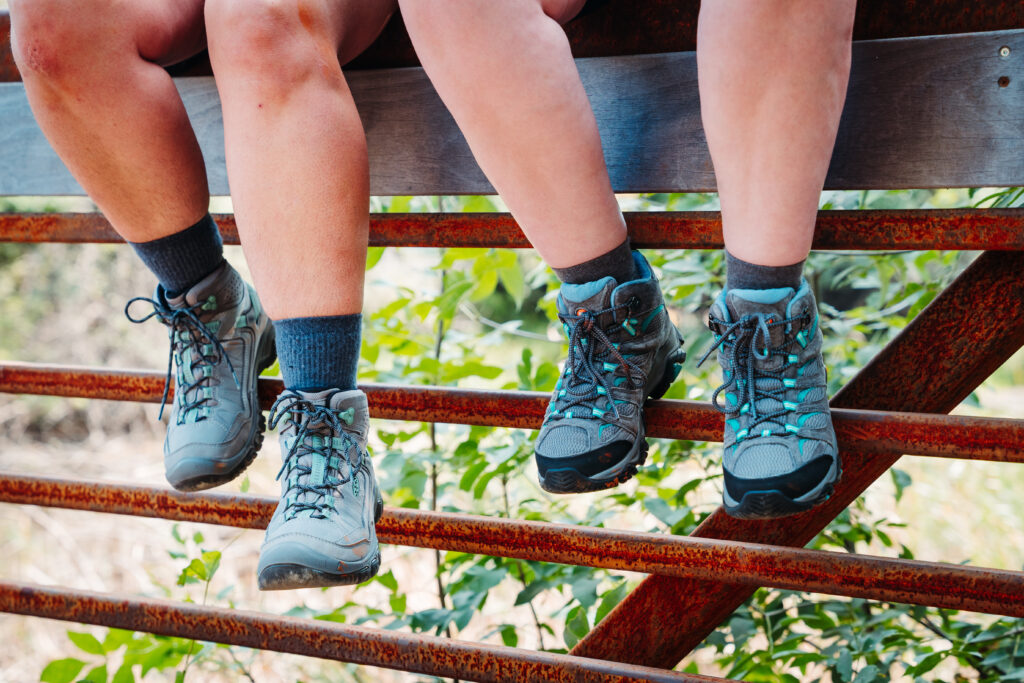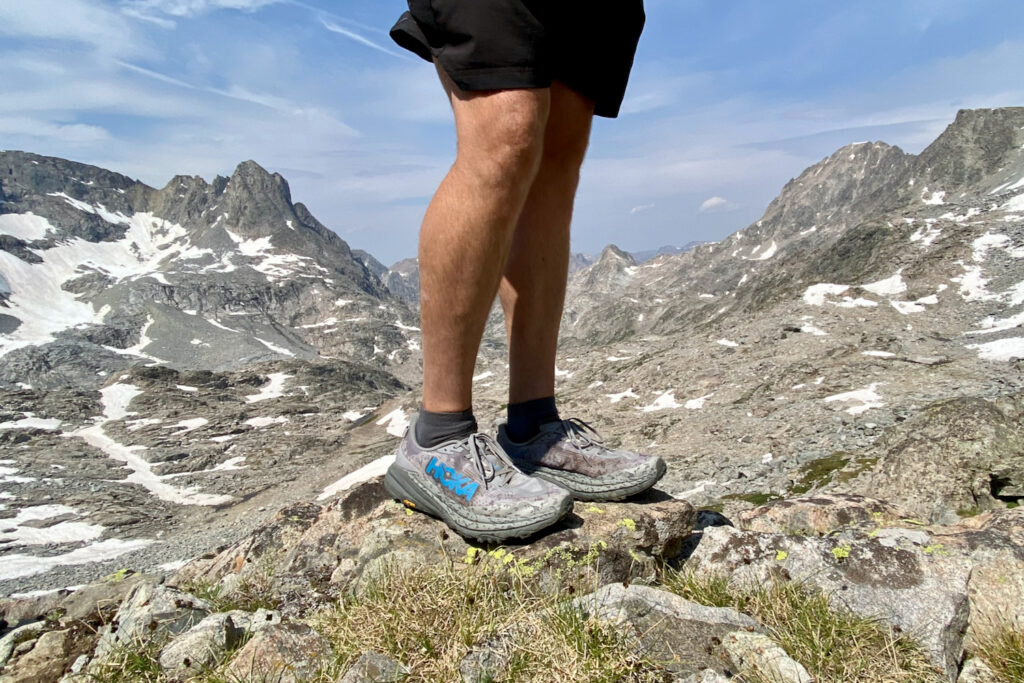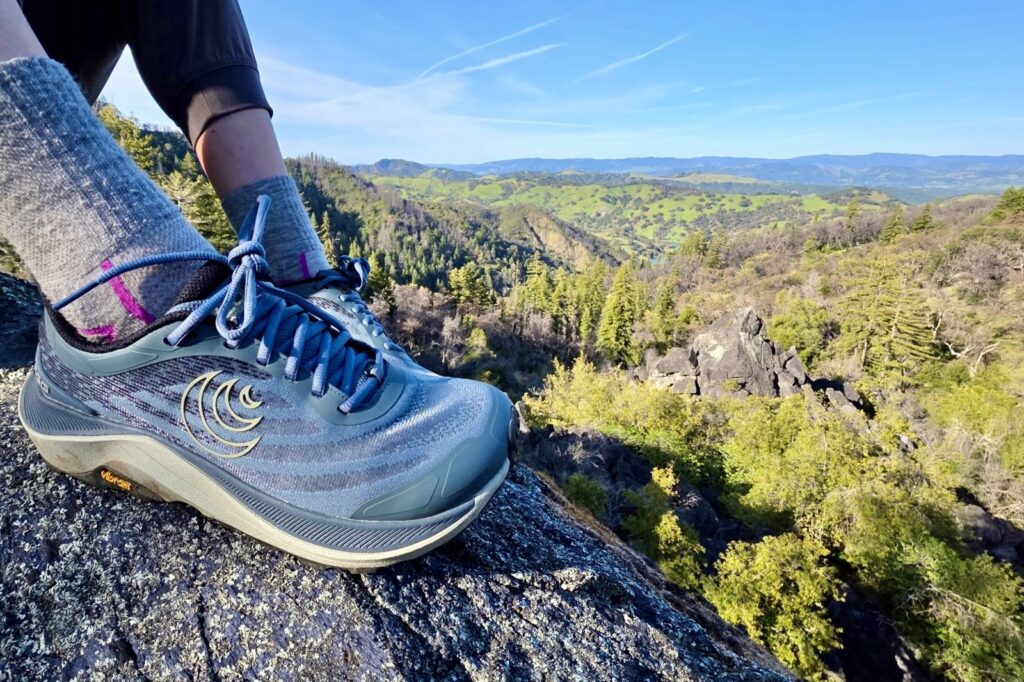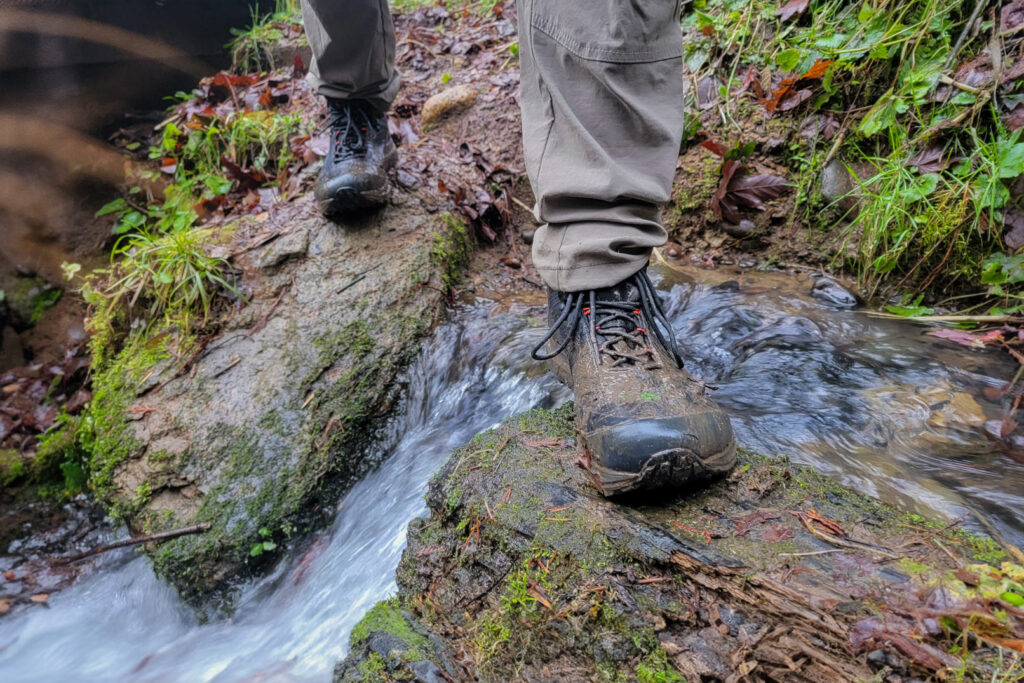
Keeping outdoor gear clean isn’t always convenient, and muddy hiking shoes are often the last thing we want to wash. However, anyone who’s had to pull on a pair of crusty boots knows that a little maintenance goes a long way.
A few fast and simple steps can extend the life of your boots and guarantee they’re ready for any adventure. In this guide, we walk you through how to take care of your footwear – so your footwear can take care of you.
Why Clean Hiking Shoes & Boots?
Just like you might want to clean off after a long hike, your boots and shoes also require regular cleaning and care. Over time dirt, mud, and moisture can infiltrate vulnerable threading, seams along the sole, and the fabric of the uppers. These particles accelerate the wear and tear on your boots and will eventually break down the shoe construction. However, routine maintenance can slow and prevent damage.
Clean shoes mean a more comfortable and healthy environment for your feet. Consistent cleaning prevents the growth of bacteria and keeps your shoes dry and odor-free. Even in a hiking culture that wears dirt and sweat as a badge of honor, there’s no glory in wet, filthy, or super stinky shoes.
A clean shoe can easily flex, breathe, and move with your foot the way it was designed, instead of fighting against caked debris. In addition, clean shoes have better grip. Mud-covered soles reduce traction and increase the risk of slips and falls. Over time, lingering gravel, dirt, and sand can passively destroy the lug pattern by degrading the rubber.

Do I Need To Wash My Hiking Shoes or Boots?
The answer is: probably! Here are ways to tell if it’s time to clean your footwear.
- Seasonal – We recommend a deep clean of your hiking boots or shoes at least twice a year for moderate use and 2 to 3 times a month for a pair in heavy rotation. If you wear the same boots multiple times per week through a hiking season, it’s been more than 30 days, or you can’t remember when they were last cleaned, time is up.
- Dirt – If any part of your shoes or boots are still caked with last weekend’s romp through the woods and you can still see obvious dirt, gravel, sand, or other debris, a light cleaning will not cut it.
- Smell – Both leather and synthetic materials harbor odor-causing bacteria, especially once they’re wet. Moisture, whether it’s from sweat, a river crossing, or a surprise thunderstorm, can cause the foam and fabric to reek. Don’t ignore that funky smell.
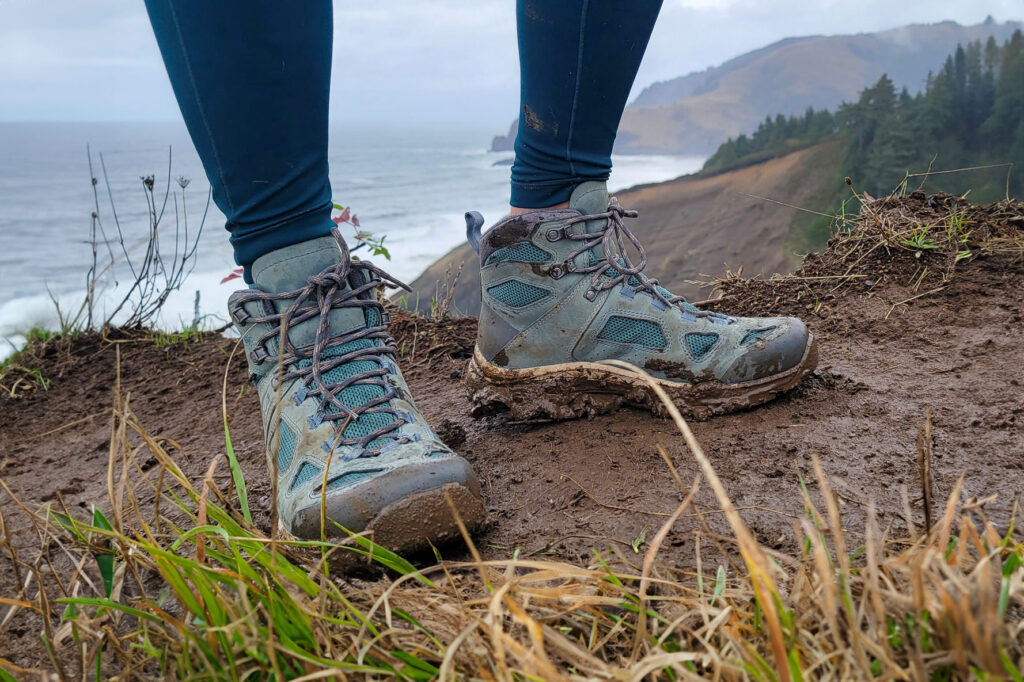
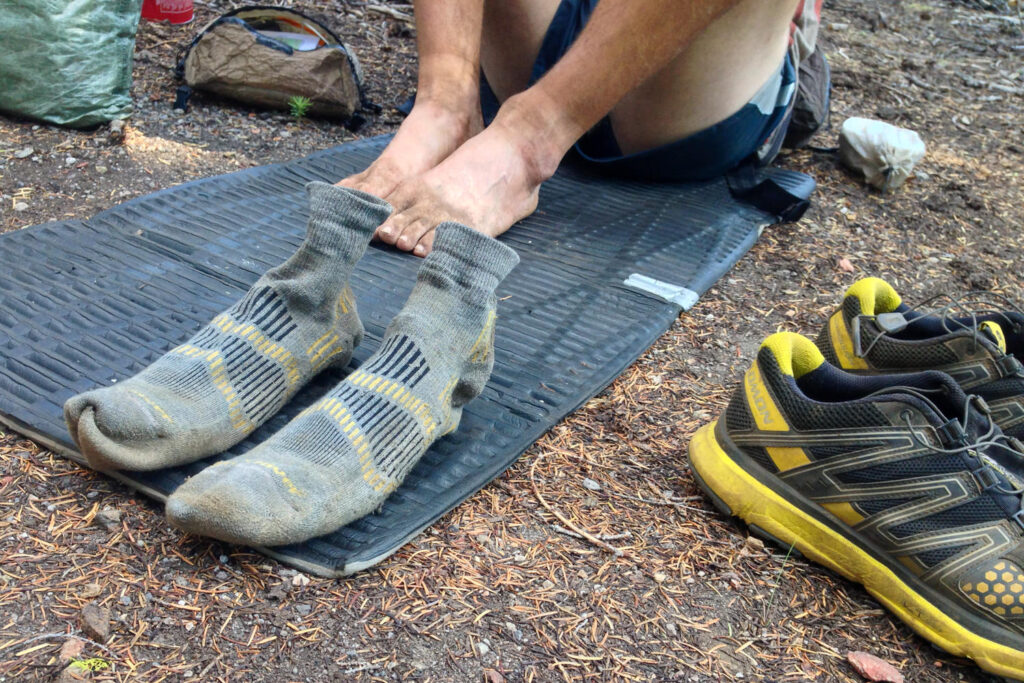
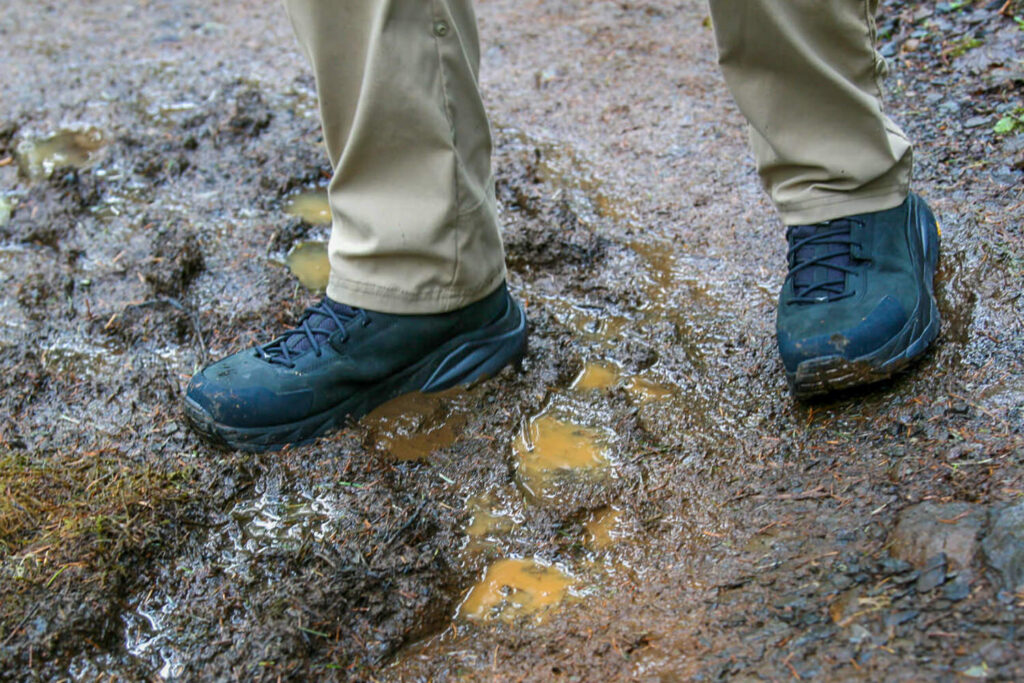
- Weather – How often you clean your footwear depends on the time of year and the season when you’re most active:
- Summer – The heat of summer often means sweatier feet and stinkier shoes. A low-maintenance spot clean with soap and water, wiping your shoes clean, and using odor-eliminating tactics (like baking soda) may be all that’s needed.
- Spring and Fall – In shoulder seasons, you’re likely to encounter all conditions including rain, snow, and mud, making for messier shoes and regular cleaning. While it’s unreasonable to clean your shoes every time they get wet, spring and fall hikes require giving your shoes more attention. We recommend a deeper clean after really muddy or mucky adventures, and a spot cleaning as needed after rainy or wet hikes.
- Winter – Wet, cold, and snowy hikes require mindful cleaning habits. Hiking in winter often means your footwear will be cold and wet. For synthetic gear, take waterproofing steps and be sure your boots are fully dry before storing. For leather uppers, that means consistent reapplication of conditioner and waterproof sprays as often as needed to keep leather strong and moisturized.
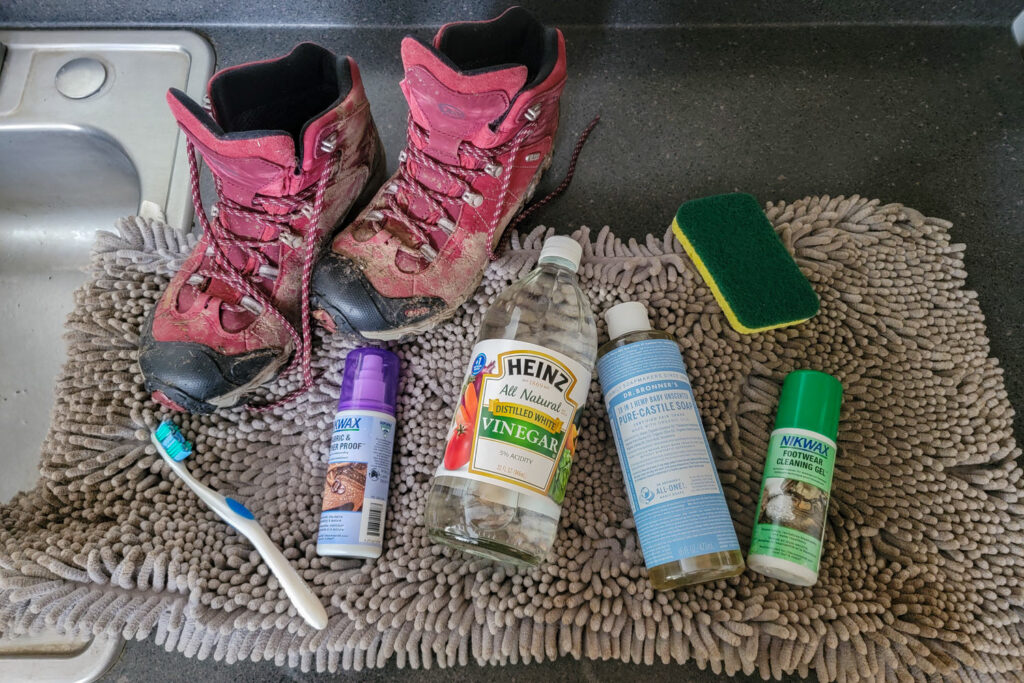
Materials Needed
You need only a few items to keep your hiking footwear in tip-top shape:
- Clean water – Water from a clean household source.
- Mild soap – Avoid “regular” bar soaps, hand soaps, and detergents with heavy fragrances and dyes. These products can stain, strip, and damage the membranes in leather and synthetic materials. We recommend an unscented, non-detergent, mild dish soap like Dawn Soap Free & Clear or a basic castile soap like Dr. Bronners Unscented.
- Vinegar – Diluted with water to remove stains and eliminate smells.
- Footwear-specific cleaners – There are excellent products made for cleaning both leather and synthetic options. Depending on the shoe material, you may need more than just a cleaner.
- Cleaner – We highly recommend a cleaning gel like Nikwax Footwear Cleaning Gel, effective for both synthetic and leather shoes. We also like Grangers Shoe and Outdoor Gear Cleaner. Grangers also offers a full Footwear Cleaning Kit.
- Leather Conditioner – For leather uppers, you’ll need a conditioner to prevent the leather from cracking and drying out after a wash. We like Nikwax Liquid Conditioner for Leather. Or, go for a full kit like Gear Aid Revivex Leather Boot Care Kit.
- Waterproofing Spray – This is an optional extra step to protect boots and shoes in wet conditions. We like Nikwax Fabric and Leather Waterproofing Spray for both synthetic and leather options. For all-leather uppers, we like Nikwax Waterproofing Wax For Leather. For nubuck leather or suede, consider Nikwax Nubuck and Suede Waterproofing Spray.
- Bucket – A sink, bucket, or any container to mix water and soap.
- Cleaning tools:
- Toothbrush – An old toothbrush to clean small crevices and details.
- Soft Bristle Brush – A large brush to scrub material without damaging it.
- Clean cloth or sponge – To wipe the surface of the shoe.
- Drying tools:
- Baking Soda – Helpful in absorbing and neutralizing odors.
- Paper Towels – Place inside wet shoes to absorb excess moisture.
- Shoe Trees – Maintains the shape of boots or shoes and holds footwear open as they dry.
- Shoe / Boot Dryer or Fan – Speeds up the drying process and cuts drying time in half.
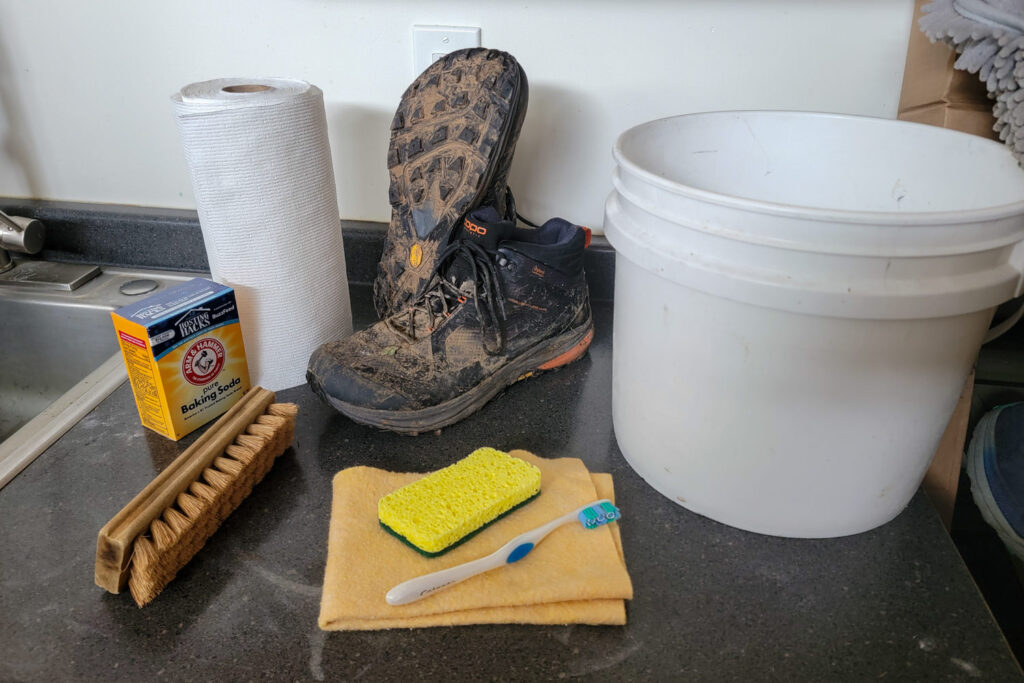
Spot Cleaning Hiking Shoes & Boots
Sometimes all your hiking shoes or boots need is an attentive spot clean. If you’re crunched for time or you’re just between hikes, a light cleaning is a fast way to refresh your boots.
- Inspect – After every hike, look over highly soiled areas externally like the outsole, sides, and upper for notable grime or damage.
- Knock off – Remove any large amounts of caked or clumped dirt, gravel, or obvious debris with hands or a dry brush.
- Spot clean – Fill a bucket with 5 parts water to 1 part soap. For an effective small-area cleaning on the outside of the shoe, soak a clean cloth or sponge then gently scrub the shoe until all soiled areas are lathered and cleaned.
- Brush – Next, use a soft-bristle brush or a toothbrush to work the soap into the affected area.
- Spot rinse – Using warm water, clean the soapy areas. Make sure all soap is removed.
- Air dry– Loosen the laces, remove the insole, open the shoes, and leave the pair in a warm, dry place to air out before storing. Consider using a fan or shoe dryer to speed up the process. This can take anywhere from 12 to 72 hours.
- Fight the stink – This is a helpful step for any lingering scents. Mix 1 part water to 1 part vinegar and lightly spray the interior of the shoe. Or, place a few tablespoons of baking soda in a muslin bag, old sock, or coffee filters to leave in the shoe until they’re dry. The baking soda will absorb lingering smells and absorb additional moisture.
Deep Cleaning Hiking Shoes & Boots
Different fabrics require slightly different cleaning steps. Knowing what your hiking boot is made from can help inform how, and how often, you’ll need to clean your footwear. To find the composition of your shoe, look at the inside of the upper tongue or hop onto the manufacturer’s website. Make sure to follow any warnings or rules about cleaning your footwear.
To revitalize your favorite boots, follow these steps. This cleaning process will work for most hiking shoes and boots including leather or synthetic uppers, waterproof and Gore-Tex materials, and insulated boots.
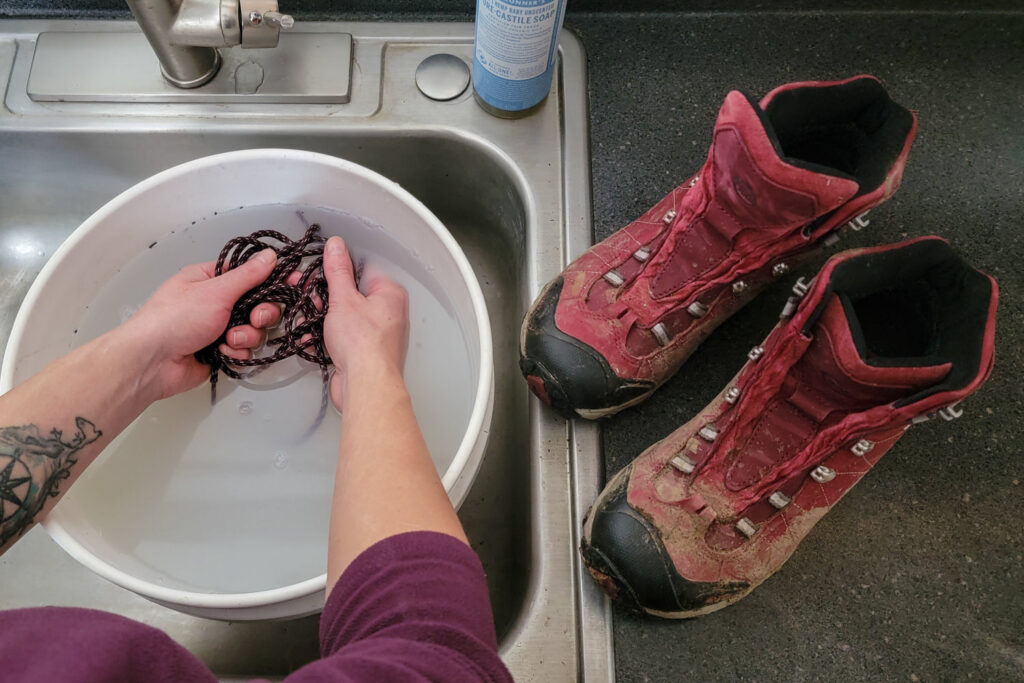
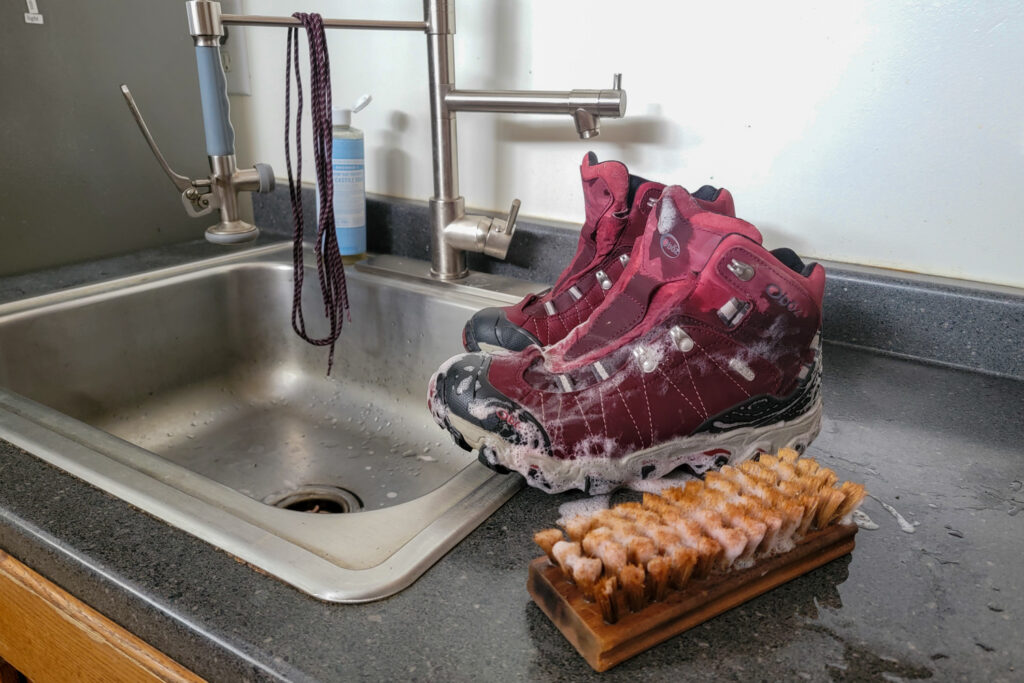
- Prepare your footwear – Start by knocking off any visible dried or loose debris and dirt. Next, remove the insoles and laces from both shoes, so you can clean every nook and cranny.
- Cleaning laces and insoles – Most shoe laces and insoles can be washed with mild soap and water.
- Rinse – Hold both insoles and laces under a stream of water to remove major debris and obvious dirt.
- Wipe – Wipe down the laces with a lukewarm, wet, soapy cloth. Do the same with insoles.
- Soak – Soak laces and insoles for 5 to 10 minutes in a bucket or container of warm, soapy water.
- Rinse again – Run soles and laces under water to remove all soap and soap residue.
- Vinegar spritz– We recommend a mix of 4 parts water to 1 part vinegar to de-stink your shoe sole. Spray this solution across the top of the insole to prevent smells and kill any lingering bacteria.
- Dry – Place insoles and laces on a dry cloth to air-dry. Never use a heat source to speed up the drying process and allow them to dry completely.
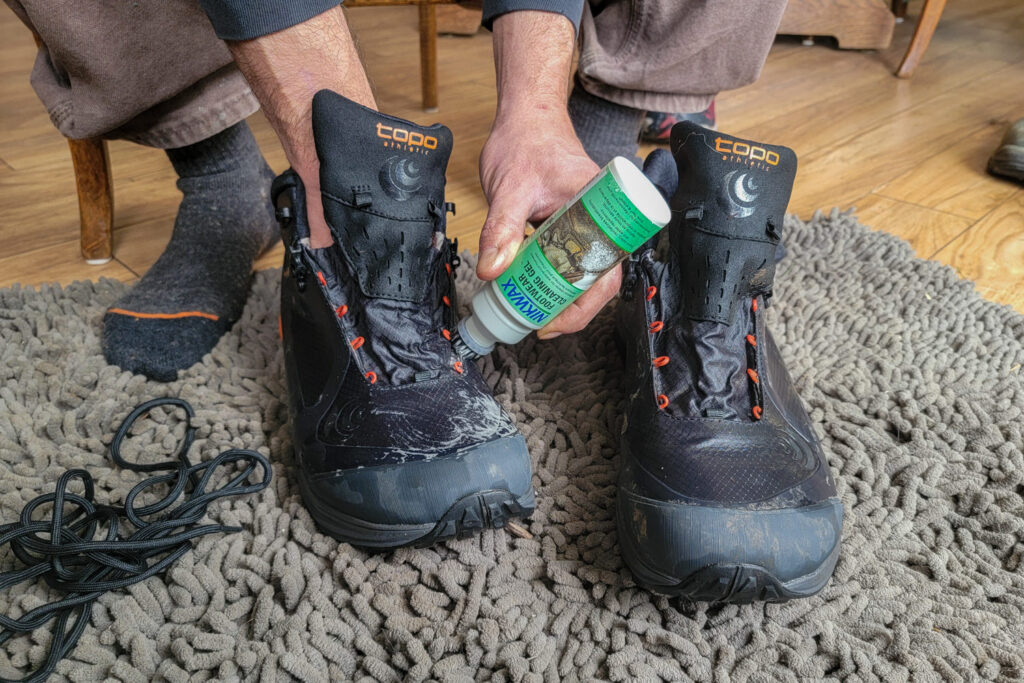
- Cleaning the outside
- Water – Wet down the entire shoe or boot with a sponge or cloth. Really dirty shoes might need a hose, but usually, a bucket of warm water or a faucet over a large sink is enough.
- Soak – For especially gnarly cases, consider leaving your hiking boots or shoes fully submerged in a bucket of warm water to soak for 10-15 minutes. The water will break down the muck and penetrate the shoe, making it easier to clean. When time is up, take a soft-bristle brush and scrub the outside of the shoe to loosen any grime. Empty the bucket and refill it. Repeat this soaking process until the water stays mostly clear.
- Soap and water – If you’re using soap, mix 1 part mild dish soap or castile soap with 5 parts water. Using a clean cloth or sponge, gently wash the sole and the upper of the boot. Give extra attention to high-use areas prone to damage from dirt buildup like the seam of the soles, the toe cap, and around the lace eyelets. Soap up the entire shoe from bottom to top, working your way around every part of the shoe until it’s foamy to the collar of the shoe.
- Cleaning gels and sprays – If you’re using a cleaning gel or spray, open the product and follow the directions on the label. In the case of Nikwax Footwear Cleaning Gel open the cap, break the seal, and apply the bottle directly onto the footwear. The bottle distributes cleaning solution with pressure, and bristles around the rim can be used to clean the boot directly. For sprays, douse the upper and outsole of the shoe and use a sponge or damp cloth to massage the solution into the shoe.
- Brush – With the soap or cleaning gel still on the shoe, dampen a large, soft-bristle brush and apply it to the sudsy exterior of the boot. Moving in small circles, work around the entire shoe, including the sole. The goal is to clean every seam, fold, and overlay on the shoe. For small areas like the lacing eyelets and tongue, use a toothbrush to remove grime.
- Rinse – Once the outside of the shoe is covered in cleaning solution, rinse it off. You can fully submerge the hiking boot or shoe in water to ensure soap is removed from every seam. Avoid leaving any soap that could dry out or damage the material.
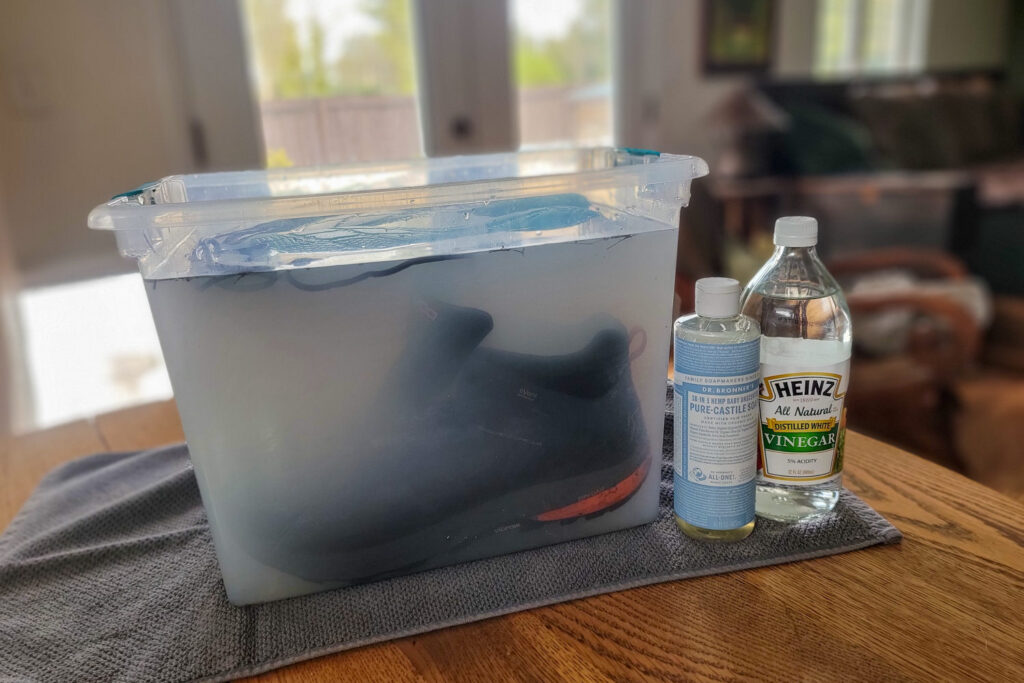
- Cleaning the inside – The inside of most hiking shoes or boots is a soft material lining the upper, attached to a tough midsole. To clean it:
- Cloth – Use a wet, soft cloth. Avoid brushes to prevent damage to the soft internal fabric.
- No soap – We don’t recommend soap because it can be difficult to remove, and might linger in the absorbent interior fabric. Use only water or a water/vinegar solution instead.
- Vinegar – For extra smell-reducing power, we recommend a mix of 4 parts water to 1 part vinegar. Use this as the primary solution to clean the inside of the hiking shoe or boot.
- Hand-clean – Applying pressure, dab and wipe the interior of the shoe in a circular motion, moving from toe to heel. Methodically wipe down the entire inside of the shoe with the cloth.
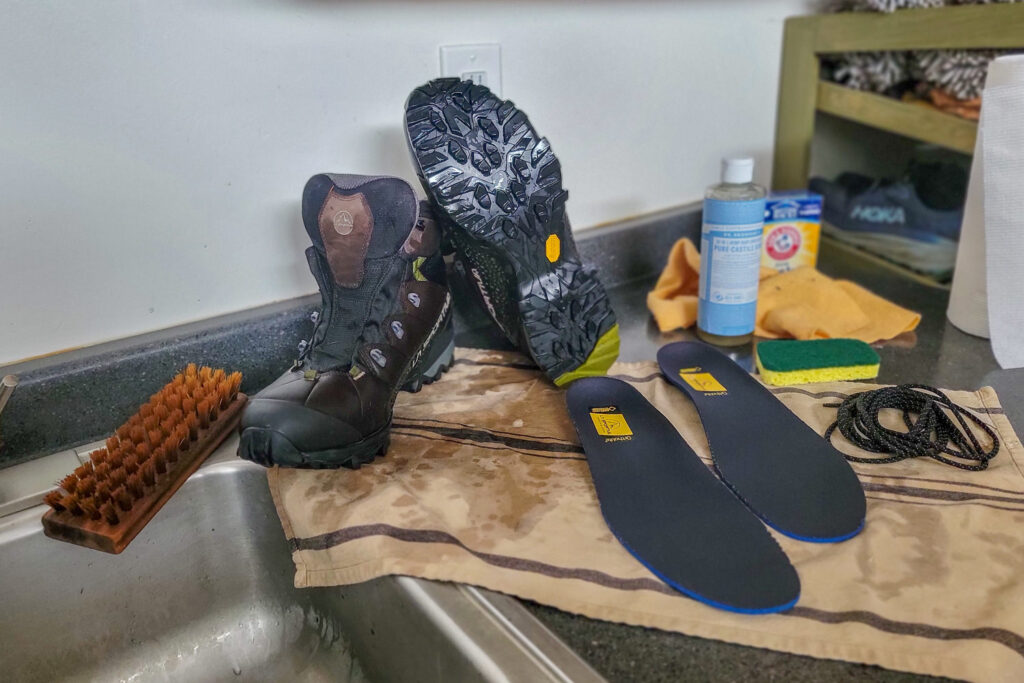
- Insulated boots – Insulated boots often have an additional liner to retain body heat. We recommend removing and soaking this liner in a soap and water solution like in step 2b and drying it separately from the rest of the boot before replacing. Otherwise, you can follow the same steps as above to clean even your heaviest winter boots.
- Stain and mold removal – Were your shoes stored wet and have mold damage? Are they covered in stubborn oil or grass stains, dirt, or scuff marks? Vinegar is the answer. Vinegar is mild on most fabrics, kills mold spores, and if it doesn’t remove the damage from a stain, it will likely lighten any discoloration. This solution is safe for both leather and synthetic shoes.
- Mix – We recommend a mixture of 4 parts water to 1 part vinegar.
- Clean – Using a soft cloth or brush, work the vinegar solution deep into the fabric of the outsole where the stain or mold is. Repeat until the area is thoroughly soaked. Let sit for 5 minutes.
- Repeat – Repeat 2-3 times.
- Rinse – Wash the solution off with water. Make sure vinegar is removed from the material.
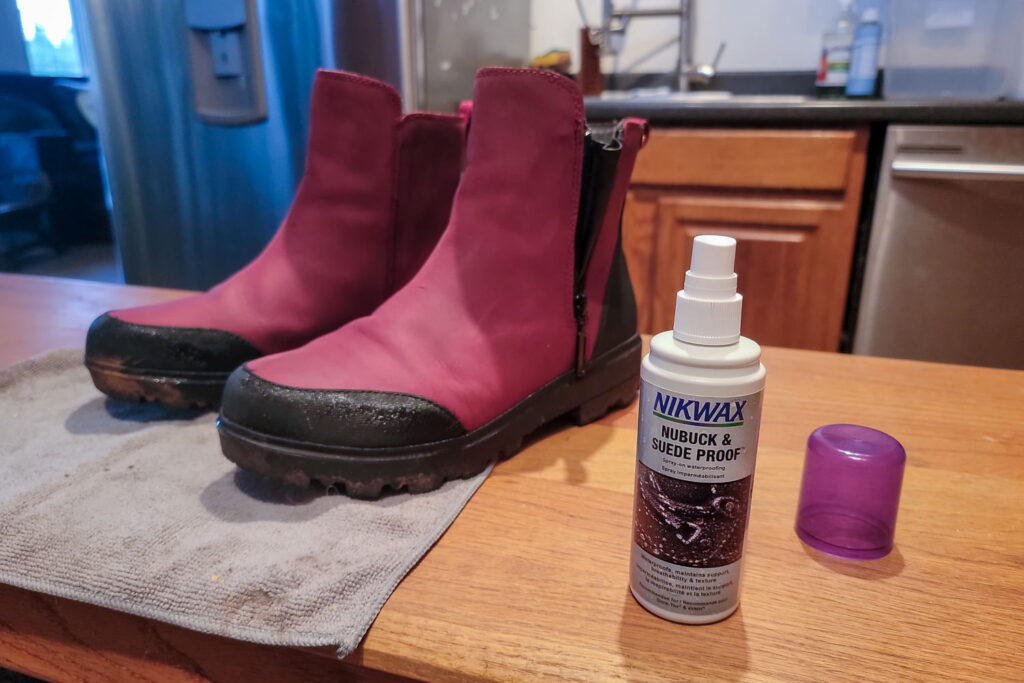
- Leather conditioning – If you have leather boots, this step is for you. If you have synthetic boots, move to step 8.
Conditioning is a must to guarantee your leather boots stay comfy, fashionable, and functional. Over time, the natural oils in the leather dry out. Dry leather becomes brittle and stiff. It eventually cracks and splits whereas supple, hydrated leather stays durable and water-resistant for years.
Be sure to apply leather conditioner immediately after cleaning. Your boots should still be wet from washing. We recommend Nikwax Liquid Conditioner For Leather. Like the other products in the Nikwax line, open the cap, break the seal, and apply the bottle like an oversized glue stick. Make sure to cover all parts of the leather. Give the conditioner 2 to 3 hours to soak in, then move on to the next step.
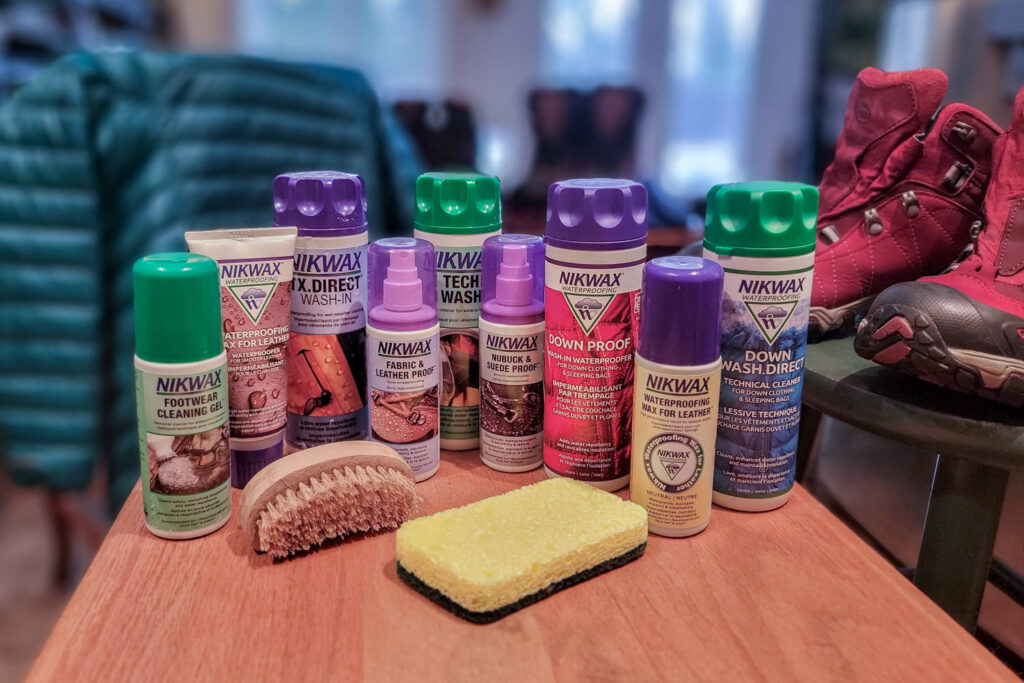
- Waterproofing – The more you use waterproof boots, the more often you’ll need to repeat this process – especially in wet conditions. Note that not all hiking boots and shoes need waterproofing, so be sure to check manufacturer care tips before adding any product to your shoes. Waterproofing your shoes is fast, easy, and the last step before drying.
- Synthetic, Hybrid, and Leather – We recommend a catch-all product like Nikwax Fabric and Leather Waterproofing Spray. Open the cap and spray the bottle directly onto footwear. You’ll want to cover the upper of your shoe or boot. Be sure the mixture reaches all seams and corners.
- Leather – For all-leather uppers, we prefer Nikwax Waterproofing Wax For Leather. This liquid wax is massaged into the leather and creates a powerful shield that helps your leather boots resist the elements and last longer.
- Nubuck or Suede – Nubuck leather is more affordable than full grain leather, but considerably more fragile. Like suede, Nubuck’s fine texture, thin membrane, and soft feel make it more prone to stains, water damage, and discoloration than synthetic or full-grain leather alternatives. However, it’s not uncommon for these materials to be used on high-end shoes. For Nubuck leather or suede, consider Nikwax Nubuck and Suede Waterproofing Spray for an extra layer of protection.
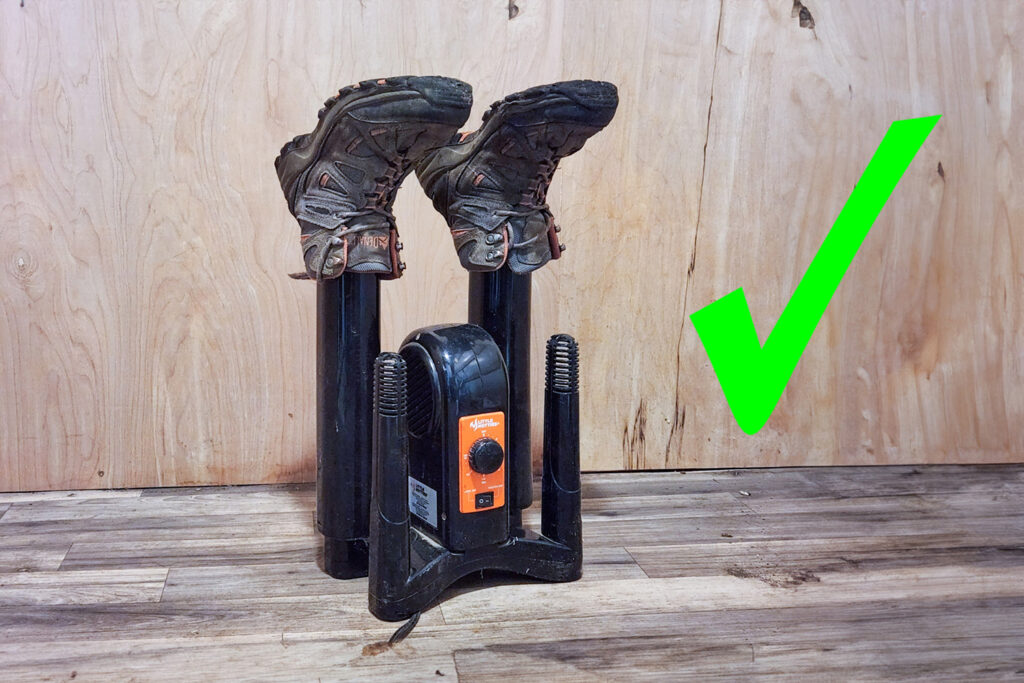
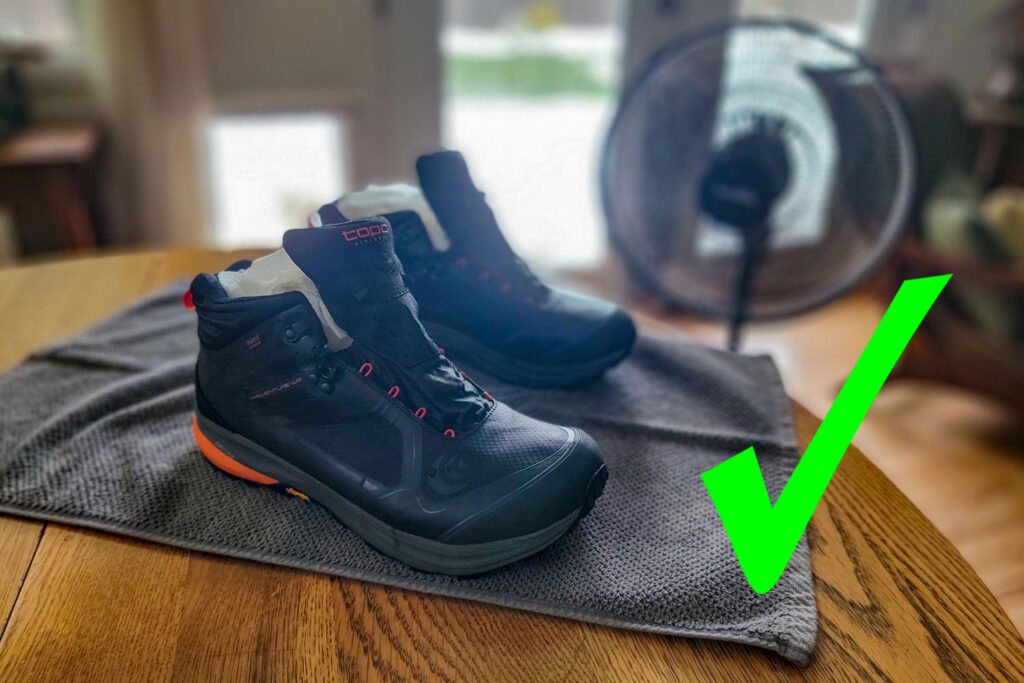
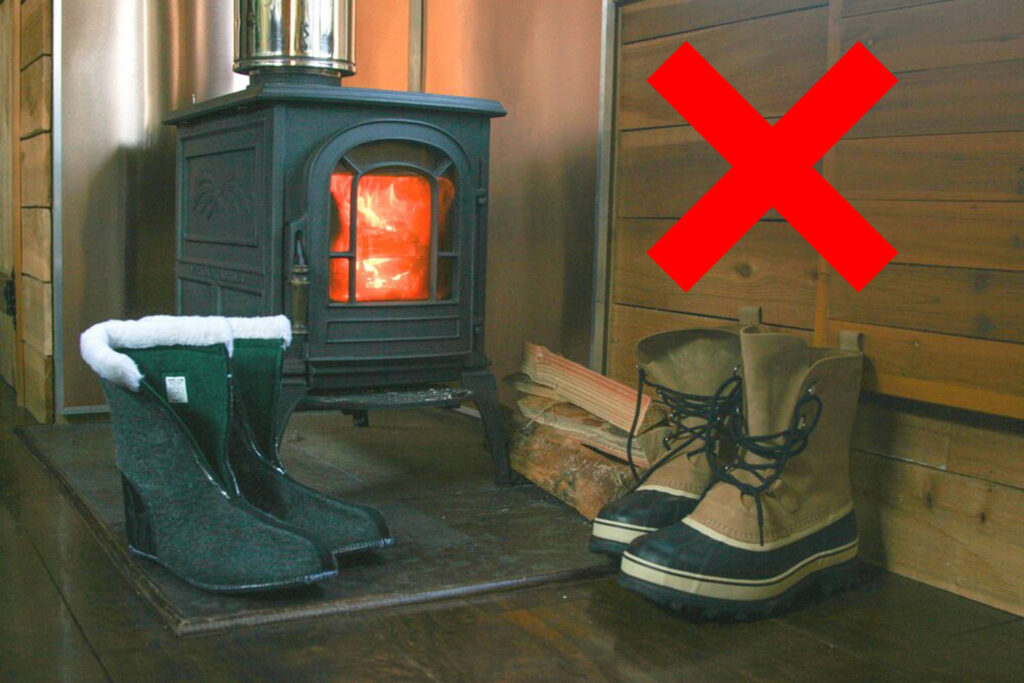
Drying Your Hiking Footwear
Allowing your boots to dry out completely adds longevity and freshness for your next adventure. Storing wet shoes can lead to permanent damage and persistent odors. Patience is the key after a deep cleaning. You’ll need to budget 1 to 4 days for your shoes to thoroughly dry.
Air dry – It’s this easy: leave your boots indoors at room temperature until they’re dry. Place them on a shoe rack or a location with good ventilation to prevent stagnant air or smells.
Paper towels – Stuff bunched-up paper towels or newspaper inside wet shoes to absorb excess moisture for the first 30 minutes of drying. Be sure the paper isn’t so tightly packed that there’s no airflow. After half an hour, remove and discard the paper towels.
Shoe trees – We recommend using a pair of inexpensive shoe trees to hold your hiking boots or shoes open as they dry. Shoe trees help maintain footwear’s natural shape through the heel and toe.
No heat – Avoid using heat to dry your hiking boots or shoes. Never dry your footwear near radiators, on top of heaters, or next to a fire. Direct, intense heat sources can melt synthetic fabrics, weaken adhesives, and lead to cracks and warping in leather. If the heat source is too intense, it can even distort the shape of rubber soles and disfigure the lug pattern.
Fan or vent – To speed up the process, place your shoes near a floor fan on high, or 1 to 2 feet from an indoor vent. Additional airflow will aid the drying process.
Boot dryer – To dramatically speed up drying times, we recommend a reliable boot dryer. These devices quietly blow lukewarm air into your boots with tiny fans for lots of ventilation. Boot dryers can cut drying times in half. That makes them ideal for regularly washing boots or for folks who need dry boots for an adventure the next day.
Fight the stink – When shoes are halfway done drying, consider these additional steps to prevent lingering scents. We recommend:
- Vinegar – Vinegar is a powerful deodorant that can kill fungus, bacteria, mold, and other odor-causing microorganisms. Mix 1 part water to 1 part vinegar in a spray bottle, and lightly spray the interior of the shoe before it’s dry. Do not soak the material. Leave the solution to air dry with the rest of the shoe for a neutral, crisp scent afterwards.
- Baking soda – Baking soda can also deodorize your shoe as it dries, and will assist with moisture absorption. For easy cleanup, we recommend a few tablespoons of baking soda in a reusable pouch, coffee filter, or old sock. Leave this small package in the boots until dry. Plus, you can continue using these baking soda odor eliminators for weeks. Or if you don’t mind the mess, sprinkle 1-2 tablespoons directly into the shoe itself and shake to cover the inside of the shoe.
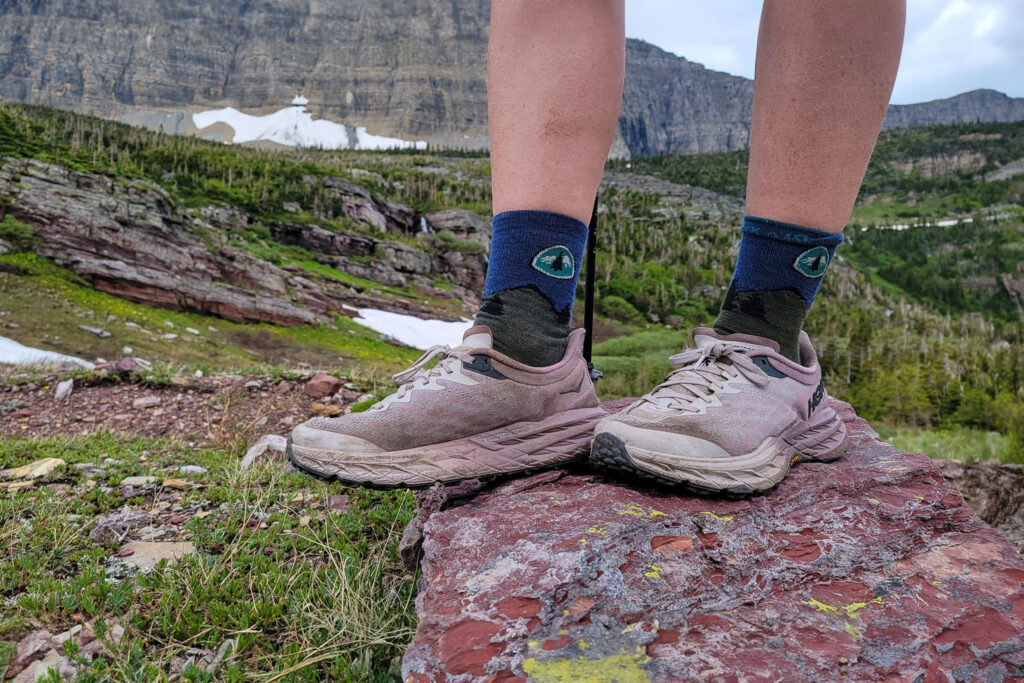
Storage Tips
How you store your most valuable hiking gear is as important as keeping it clean and maintained.
Cool and dry – Over time, direct sunlight and extreme cold or hot temperatures can weaken adhesives, compromise fabrics, and deteriorate rubber compounds. Keep your hiking boots in a cool, dry place like a closet or shoe rack.
Pests – If pests like rodents or insects are an issue where you live, consider storing shoes in a boot box or dust bag for a little extra protection – but never in a vacuum or compression sack.
Compression is bad – Boots stored with heavy objects on top, or in a pile with other footwear, will lose their shape. Compression can wreck the integrity of the materials. Your boot was likely compressed if it has a smashed or lopsided look, doesn’t return to its initial shape, or doesn’t fit how it once did after a winter in a shoe pile. We recommend storing boots in an upright and open position and in a dedicated place in your house. If you’re concerned about your shoe losing shape, consider using inexpensive shoe trees to prevent your favorite hikers from becoming misshapen during storage.
Air is good – Moisture buildup is your hiking boots’ enemy. Avoid storing boots in damp garages, sheds, or crawlspaces. To maximize ventilation of the boot when not in use, remove insoles, loosen boot laces, and open the tongue so there’s airflow around the shoe.
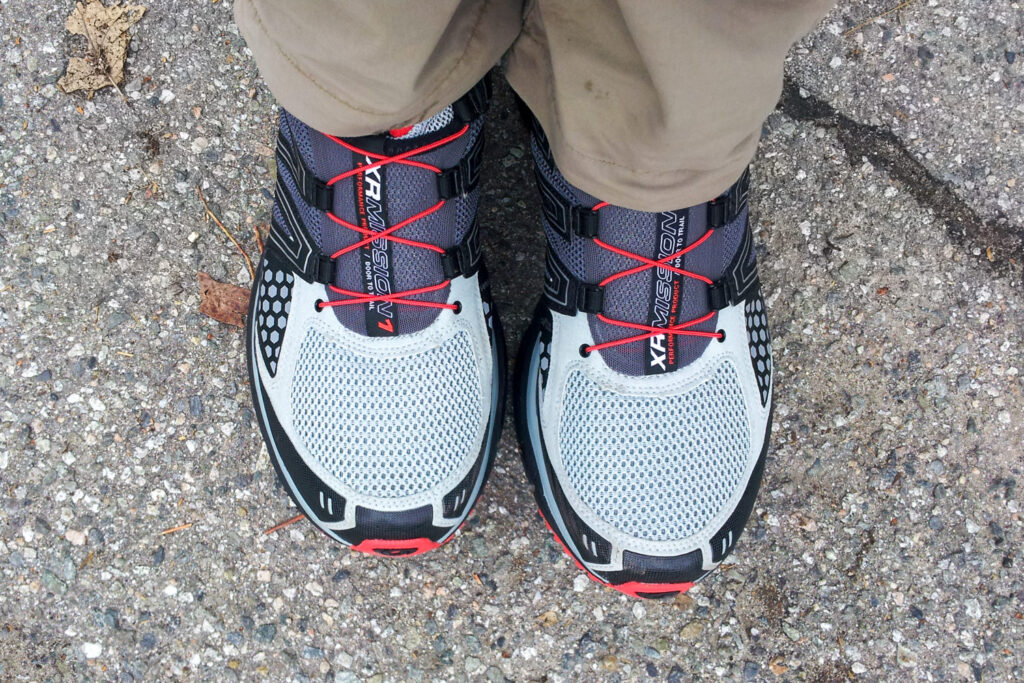
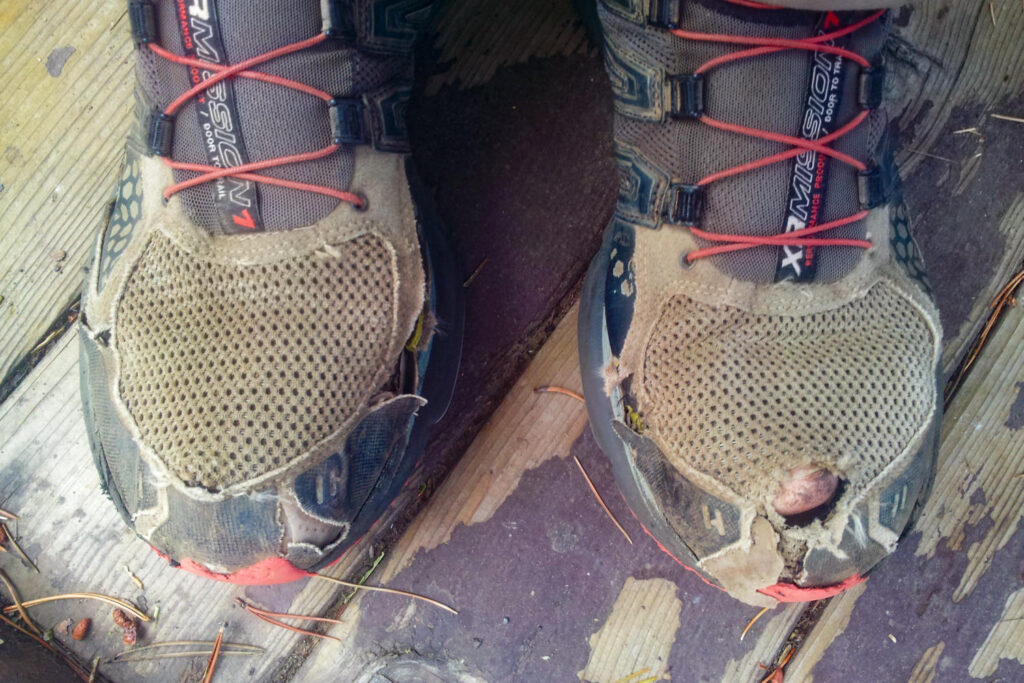
Damage Control
Once a month, we recommend assessing hiking shoes for signs of wear, damage, or separation from the uppers. Even the most innocuous hike can cause unexpected wear and tear. Regular inspection prevents further damage from roots and rocks.
Damage to uppers – In most cases, major tears and rips to the upper of a hiking boot are unrepairable. On a hike, you might be able to perform a temporary fix with duct tape, but we recommend always carrying a lightweight, high-quality gear fabric patch like Tenacious Tape. In the long term, you’ll need new shoes.
Damage to soles – For damage on the soles of your footwear, we recommend a long-lasting sealant gel like Gear Aid Aquaseal SR. This is a super strong adhesive that acts as a second skin for worn soles. A strong sealant can temporarily patch splits between the upper and the sole, re-seal a peeling toecap, or add life to blown tread lugs.
Worn soles – Don’t replace, resole. Many brands offer fast, affordable, and effective resoling services. This is a great option for durable shoes where the upper is still in good shape, but the tread has worn down.
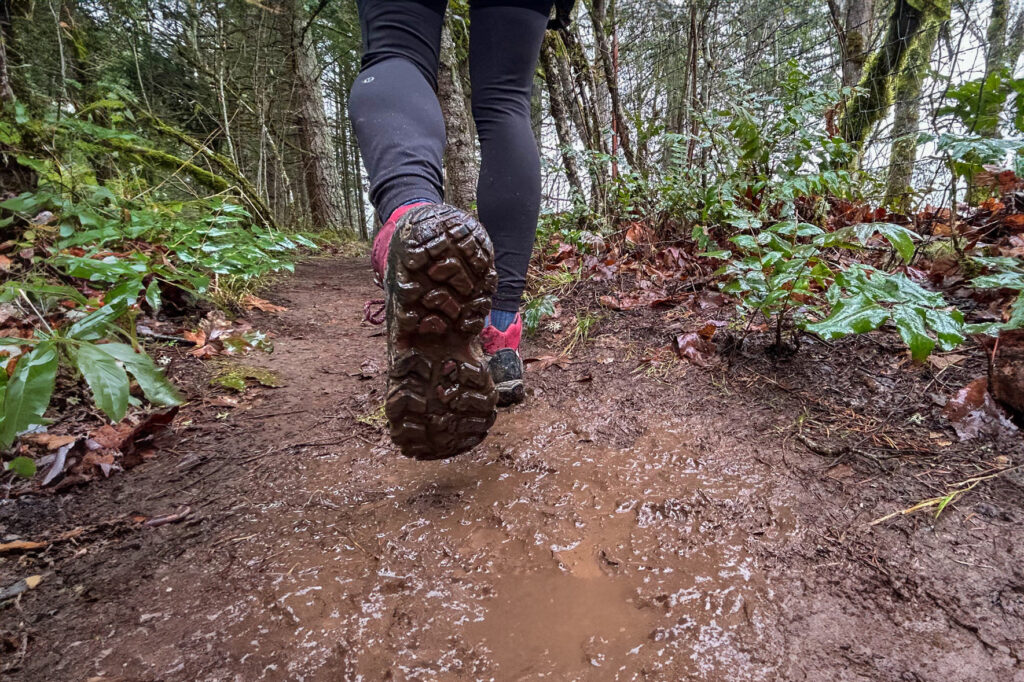
The Bottom Line
Maintaining your hiking shoes is important. Thankfully, a quick wash and scrub will work wonders since muck, grime, and odors are no match for a simple cleaning routine.
With the right products and steps, cleaning your boots and shoes can be easy and fast. An effective cleaning schedule prevents damage and keeps your footwear both bacteria and stink-free. Plus, it extends the lifespan of your favorite boots.
Cleaning your hiking shoes is a small effort with a big payoff – so don’t procrastinate. It’s the first step towards your next great outdoor adventure.
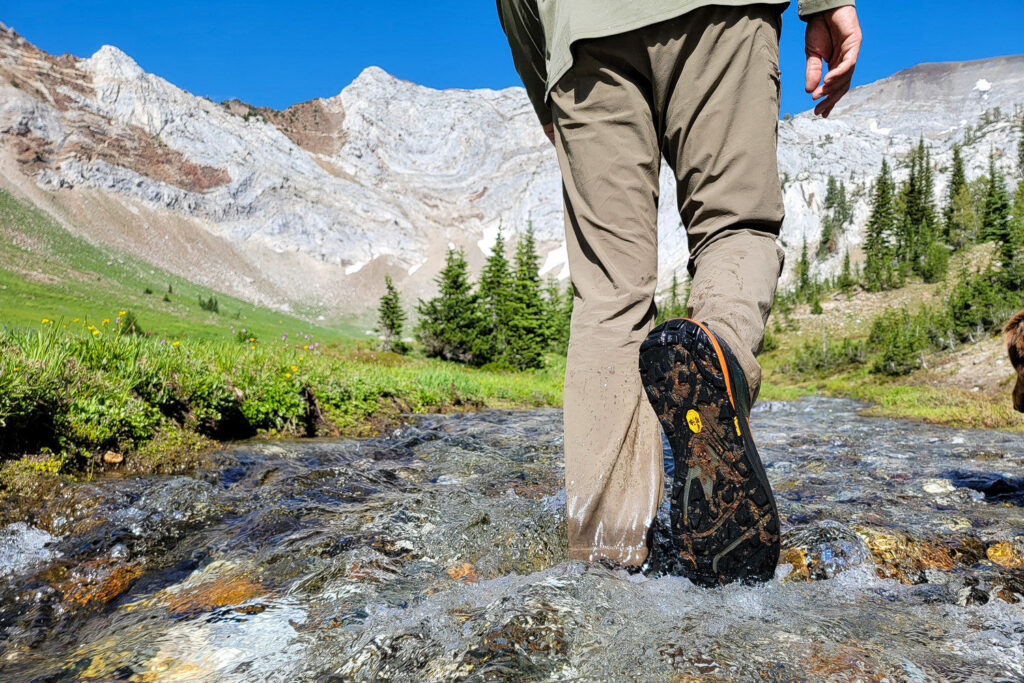
More Information
Was this guide helpful for keeping your hiking boots clean and fresh? Leave us a comment if you have any recommendations, questions, or suggestions. Or, visit us on Facebook and Instagram to stay updated with the latest and greatest in hiking gear and current trends.
Be sure to check out the CleverHiker Gear Guide where our team of experts tests and reviews the best outdoor adventure equipment on the market – so you don’t have to. Here are other articles you might like:
- Best Trail Runners for Hiking – Men / Women
- Best Hiking Shoes – Men / Women
- Best Hiking Boots – Men / Women
- Best Rainboots – Men / Women
- Best Winter Boots – Men / Women
- 10 Best Hiking Socks
- How To Prevent and Treat Blisters While Hiking
- Hiking Boots vs Shoes vs Trail Runners
- 5 Reasons to Ditch Your Hiking Boots


